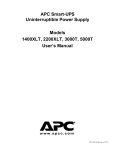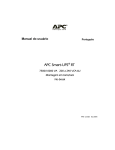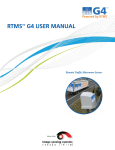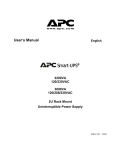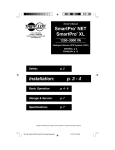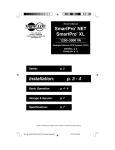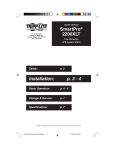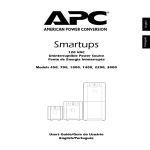Download APC 1400XLT Power Supply User Manual
Transcript
Smart-UPS ® Models T, 3000XL T 1400XL T, 2200XL 3000XLT 1400XLT 2200XLT User’ User’ss Manual Contents 1. Introduction ...................................................................... 3 2. Safety ................................................................................ 6 3. Presentation ...................................................................... 7 4. Installation ....................................................................... 10 5. Operation ........................................................................ 16 6. Alarms ............................................................................. 21 7. Options ........................................................................... 22 8. Troubleshooting .............................................................. 23 9. Service ............................................................................. 24 10. Replacing the Battery..................................................... 25 11. Storage .......................................................................... 28 12. Specifications ................................................................. 29 13. How to Determine On-battery Run Time ........................ 31 14. User Configuration Items ............................................... 33 Limited Warranty ................................................................. 36 Please note: The troubleshooting section (section 8) offers solutions for most of the difficulties you may encounter with this UPS. Before calling customer service, please have available your UPS’s serial number (see label on the rear of the UPS). A returned materials authorization (RMA) number is required for all return shipments to APC. Do not send return shipments to APC without an RMA number. See section 9. Serial number: _____________________________________________ Toll free technical support: United States and Canada Others: +1 401 789 5735 (USA) Return shipment addresses: 1-800-800-4272 American Power Conversion Corporation 132 Fairgrounds Road P. O. Box 278 West Kingston, Rhode Island 02892 USA Entire contents copyright © 1994, 1995, 1996 American Power Conversion. All rights reserved; reproduction in whole or in part without permission is prohibited. Smart-UPS is a registered trademark of APC. All other trademarks are the property of their respective owners. 1 2 1. Introduction 1.1 Thank you! Thank you for selecting this uninterruptible power source (UPS). It is designed for many years of reliable, maintenance-free service. Important! Please read this manual. It provides safety, installation, and operating instructions that will help you get the fullest performance and service life from your UPS. This manual describes the inner workings of the UPS and how they relate to providing superior protection from utility power problems such as blackouts, brownouts, sags, swells, EMI/RFI noise, and surges. The manual includes instructions for obtaining factory service if necessary. If you have a problem with the UPS, please refer to this manual before calling customer service. The troubleshooting section (section 8) can help with most situations typically encountered when using the UPS. Please save the packaging materials! The UPS’s shipping materials are designed with great care to provide protection during shipping. These materials are invaluable if you ever have to return the UPS for service. Damage sustained during transit is not covered under the warranty. 1.2 Radio Frequency Interference Warning: Changes or modifications to this unit not expressly approved by the party responsible for compliance could void the user's authority to operate the equipment. Note: This equipment has been tested and found to comply with the limits for a Class A digital device, pursuant to Part 15 of the FCC Rules and the Class A limits for radio noise emissions from digital apparatus set out in the Radio Interference Regulations of the Canadian Department of Communications. These limits are designed to provide reasonable protection against harmful interference when the equipment is operated in a commercial environment. This equipment generates, uses, and can radiate radio frequency energy and, if not installed and used in accordance with the instruction manual, may cause harmful interference to radio communications. Operation of this equipment in a residential area is likely to cause harmful interference in which case the user will be required to correct the interference at his own expense. Shielded signal cables must be used with this unit to ensure compliance with the Class A FCC limits. 3 1.3 Theory of Operation This high-performance, line-interactive, uninterruptible power source (UPS) provides clean, reliable, AC power to computer systems and other electrical equipment — protecting them from power blackouts, brownouts, swells, sags, surges, and interference. It is designed to provide protection for equipment that operates on 208 volts AC, as well as peripheral equipment requiring 120 volts AC. The UPS requires single phase 208 volts AC input for proper operation. Typically, this is supplied by connecting the UPS to two phases of a three phase 208V delta or 120V wye service. The primary output is single phase 208 volt AC. An auxiliary 400VA, (3.3 amps), 120 volt AC output is provided to receptacles on the rear panel by an internal isolation transformer with the output neutral grounded. When the front panel display or the optional software report the amount of load, the load on the 120 VAC output is not reported separately, but it is included in the total load. This means that the 120 VAC load is accounted for when calculations are made to determine the amount of run time remaining. Note: Any load on the 120 volt output reduces the maximum load that can be powered by the 208 volt output. Note: The 120 VAC output is provided by an isolation transformer which adds resistance in series with the equipment to be powered. As a result, the 120 VAC output variation due to load (expressed as a percentage of nominal output) will be greater than the 208V output it is powered from. This should not be a problem for most equipment that will be powered. See Section 12 for more information. Normally, the UPS operates “on-line,” supplying power from the utility input to the load (workstation, server, or other device). The converter circuitry is used to maintain an optimal float charge level on the battery. When the utility fails, the converter supplies AC power to the load and the disconnect switch opens. The loads operate normally until shut down or until the battery is exhausted. The UPS automatically transfers the load back to utility power when the line voltage returns to normal. The UPS also provides surge protection and EMI/RFI filtering, as well as Smart-Boost™ and SmartTrim™, which correct high and low input voltage without drawing power from the battery. Output control uses the UPS’s remote interface to turn the load on or off, without disabling other UPS functions. 4 1.4 Features Intelligent Battery Management The UPS provides visual and audible indications of the battery’s present status including capacity, low battery condition, and replace battery condition. The UPS exercises the battery during its self-test, and detects a weak battery before it is put into service. The UPS normally performs a self-test at power up and every 14 days. Self-tests can also be conducted manually with the on/test button at any time. The UPS features user-replaceable batteries. Batteries can be replaced without having to remove power from the loads or send the UPS in for service. Computer Interface and Accessory Slot Advanced monitoring, power management, and customizing functions are available through the computer interface and accessory slot. See section 7 for more information. 5 2. Safety CAUTION! ■ ■ ■ ■ ■ ■ 6 To reduce the risk of electric shock in conditions where load equipment grounding cannot be verified, disconnect the UPS from the AC power outlet before installing a computer interface or accessory slot signal cable. Reconnect the power cord only after all signaling connections are made. Connect the UPS to a two-pole, three-wire grounding AC power outlet. The receptacle must be connected to appropriate branch protection (fuse or circuit breaker). Connection to any other type of receptacle may result in a shock hazard and violate local electrical codes. The UPS has an internal energy source (the battery). The output may be energized when the unit is not connected to an AC power outlet. To deenergize the outputs of the UPS, first press the Off button for more than one second to switch the UPS off. Next disconnect the UPS from the AC power outlet. To deenergize the UPS completely, disconnect the battery. See section 10. This UPS’s protective Earth conductor carries the leakage current from the load devices (computer equipment). This UPS generates approximately 1.5 mA of leakage current. To ensure a safe limit of 3.5 mA, limit the total leakage current of the load devices to 2 mA. Use of this equipment in life support applications where failure of this equipment can reasonably be expected to cause the failure of the life support equipment or to significantly effect its safety or effectiveness is not recommended. 3. Presentation 3.1 Front panel With the UPS plugged in, press the on/test button to turn on the UPS and power the loads. See Sec. 5.1. On/test also activates the UPS’s self-test and utility line voltage displays. See sections 5.3 and 5.6. The overload LED lights when the loads connected to the UPS exceed the UPS’s capacity. See section 6.2. The battery charge/line voltage display shows the present battery charge as a percentage of battery capacity. See section 5.5. It also displays the voltage of the utility line. See section 5.6. The on-battery LED comes on when the UPS is supplying battery power to the loads. The replace battery LED comes on when the UPS’s battery is no longer useful and must be replaced. See section 10. Press the off button to turn off the UPS and the load. See section 5.2. The SmartBoost LED comes on when the UPS is correcting a low utility voltage condition. The loads receive normal power. The on-line LED comes on when the UPS is supplying utility power to the loads. The load display shows the power being drawn by the load. See section 5.4. The SmartTrim LED comes on when the UPS is correcting a high utility voltage condition. The loads receive normal power. 7 3.2 Rear Panel Tower Models Rack Mount Models 8 Use the computer interface port for UPS monitoring and control. See section 7. The configuration button changes the UPS’s sensitivity to utility voltage variations and the low battery warning interval. See sections 5.9 and 5.10. The configuration LED indicates the voltage sensitivity setting and the low battery warning interval. See sections 5.9 and 5.10. The 120 VAC output circuit breaker trips when the connected load exceeds the rated capacity. The center plunger of the circuit breaker extends when tripped. The input circuit breaker trips when the total load exceeds the UPS’s capacity. The paddle handle on the input circuit breaker shows “off” when tripped. Use the transient voltage surge suppression (TVSS) ground connector for the ground leads of telephone or network line protectors. See section 4.9. The input power connector is a power cord with a NEMA L6-20P connector. The output power receptacles are NEMA type L6-20R and L6-30R for 208V output, and type 5-15R for 120V output. An optional hard wiring kit is available. See yout dealer or call the number at the front of this manual for more information. Optional accessories can be installed in the accessory slot. See section 4.4 and section 7. Use the battery pack connector to connect the optional external battery pack. See section 4.5. 9 4. Installation To obtain warranty coverage fill out and return the warranty registration card now. 4.1 Inspection Inspect the UPS upon receipt. Notify the carrier and dealer if there is damage. The packaging is recyclable; save it for reuse or dispose of it properly. 4.2 Placement Tower Models Install the UPS in a protected area with adequate air flow and free of excessive dust. Do not operate the UPS where the temperature and humidity is outside the specified limits. See section 12. Allow the UPS to come to room temperature before continuing. Rack Mount Models Please observe the following items when installing the UPS. ■ The ‘T’ models are supplied with L-channel supports. These supports may be used to ease installation. ■ Caution: These models require two or more people to install due to their weight. ■ The UPS is not supplied with screws to attach the mounting brackets (ears) to the rack, as the size of screw varies according to the type of rack used. ■ UPSs are heavy. Select a rack location sturdy enough to handle the weight. Try to mount the UPS near the bottom of the rack. ■ Select a rack location with adequate air flow that is free from excessive dust. Ensure that the air vents on the sides of the UPS are not blocked. Do not operate the UPS where temperature or humidity are outside the limits in Section 12 of the User’s Manual. ■ Caution: Remove the UPS before transporting the rack. ■ Two additional sets of bracket holes are located on the sides of the UPS (see below). These holes allow mounting the brackets with a three inch or six inch setback. Move the mounting brackets back if desired to optimize the esthetic or physical requirements of the rack. Caution: Check the rack to make sure it won't tip after moving the mounting brackets. 10 Installing the Support Brackets 1. 2. 3. 4. 5. 6. 7. 8. Verify the contents of the kit. It contains: two adjustable-length L-channel supports, eight clip nuts, eight 10-32 x 1/2” flat-head screws, and eight washers. The washers are for use with square rack holes only. If the rack uses threaded holes, drill out the appropriate front rail rack holes with a 7/32” drill bit. This step is not required when mounting in racks with square holes. Install clip nuts on the uppermost and lowermost holes at each end of the L-channel supports. Orient the clip nut as shown in the drawing above ➌. The nuts should be to the inside of the cabinet when the supports are installed. Secure the front of the support to the front cabinet rack using two 10-32 x 1/2” flat-head screws ➍. Note that the front ear of the L-channel support has a square cutout on the mounting ear ➊, and the rear ear has no cutout ➋. For cabinets with square rack holes, use a washer under the head of each screw. Loosen the two 10-32 x 5/16” pan-head screws that lock together the two halves of the Lchannel support ➎. Slide the outer half of the support to the rear until it contacts the rear rack of the cabinet. If the rack uses threaded holes, drill out the appropriate rear rail rack holes with a 7/32” drill bit (see Step 3). Secure the rear of the support to the rear cabinet rack using two 10-32 x 1/2” flat-head screws.For cabinets with square rack holes, use use a washer under the head of each screw. Securely tighten the two 10-32 x 5/16” pan-head screws that lock together the halves of the Lchannel support ➎. Repeat steps 3 through 6 to install the other L-channel support. Slide the UPS onto the L-channel supports and use rack hardware to secure the UPS mounting ears to the rack rails. 11 4.3 Protection Strategies This UPS provides high performance power line protection to the loads. There are, however, other potential entry points for damaging surges in information systems. These include serial ports (RS232, RS-422, RS-485, etc.), parallel ports, telephone lines, and network connections. These other entry points must be considered in developing a comprehensive system protection strategy. Contact your dealer or call the number in the front of this manual for information on a complete set of related products designed to accomplish total system protection. Sensitive information systems can be further safeguarded by following these guidelines: ■ Verify that all electrical outlets are properly grounded. ■ Connect information systems to a different electrical service branch than heavy motor loads like air conditioners, copiers, refrigerators, and heavy industrial machinery. ■ Plug all power protection and information system equipment into the same branch where possible. 12 4.4 Install Accessory (Optional) Some UPS accessories connect to the computer interface (DB-9) port, while others install in the accessory slot. See the literature accompanying the accessory to determine proper installation. The screws holding the slot cover are #2 Phillips head type. To use the computer interface port, connect the accessory to the DB-9 connector and tighten down the connector’s screws. Connect the optional battery pack (3000 VA model only) according to the instructions with the battery pack. 4.5 Connect Battery Packs (optional) Install up to 10 additional external battery packs per XL model UPS following the instructions below. See your dealer or call the number at the front of this manual for information on purchasing the correct battery pack for your model. Note: The 3000 VA UPS accepts only one additional external battery pack. 1. Prepare the UPS to connect the battery pack(s). Note the holes used to attach the battery pack connector clamp (near the center of the connector opening). Use a #2 Phillips head screwdriver to remove the battery pack connector clamp from the back of the UPS. 2. Turn the clamp over and loosely attach one end at the edge of the connector opening in the UPS. 3. Holding the clamp aside, insert the battery pack connector into the UPS. 4. Secure the connector clamp. To install additional battery packs, repeat this procedure using the battery pack connectors on the battery packs. Note: Do not stack battery packs. 13 Completed XL installation with two battery packs. 4.6 Connect to Utility Plug the UPS into an L6-20 receptacle connected to a 208VAC, 20 Amp service. The service may be either 50 or 60 Hz, but it must be equipped with a safety ground. If the service at your location uses a receptacle other than an L6-20, the UPS plug may be replaced with an appropriate plug by a qualified individual. The UPS is not rated for more than 20 Amps and should not be connected to a service that supplies a higher current. Avoid using extension cords and adapter plugs. 14 4.6 Charge the Battery The UPS charges its battery whenever it is connected to utility power. For best results, charge the battery for 2.5 hours before use. It is acceptable to use the UPS without first charging the battery, but on-battery run time may be reduced until the battery charges. 4.7 Connect the Loads Plug the loads into the output connectors on the rear of the UPS. To use the UPS as a master on/ off switch, make sure that all of the loads are switched on. Test the system with all loads operating to make sure that the UPS is not overloaded. See section 6.2. 4.8 Connect Ground Leads to TVSS Connector (Optional) The UPS features a TVSS connector for connecting the ground lead on transient voltage surgesuppression (TVSS) devices such as telephone and network line protectors. The TVSS connector provides grounding through the UPS’s power cord ground conductor. Note: Do not use the TVSS connector without first verifying that the UPS is properly grounded. To make a connection to the TVSS connector, loosen the screw and connect the surge suppression device’s ground lead. See section 3.2 for the location of the connector. Tighten the screw to secure the lead. 15 5. Operation 5.1 Switch On With the UPS plugged in, press the on/test (upper) button to supply power to the loads. The loads are immediately powered while the UPS beeps and performs a self-test. See section 5.3. 5.2 Switch Off To switch off the UPS’s output power, press the off (lower) button. It may be convenient to use the on and off buttons of the UPS as a master on/off switch for the protected equipment. Note: The UPS is on (the internal processor is operating) whenever it is plugged in and utility voltage is present. Even when switched off the UPS maintains the battery charge and will respond to commands received through the computer interface port and the accessory slot. 16 5.3 Self-test Use the self-test to verify both the operation of the UPS and the condition of the battery. With the UPS plugged in to normal utility power, activate the self-test by pressing the on/test button until the UPS beeps and the on-line LED flashes. Note: By default the UPS performs a self-test at power up and once every two weeks. During the self-test, the UPS briefly operates the loads on-battery (the on-battery LED comes on). If the UPS passes the self-test, it returns to on-line operation. The on-battery LED goes off and the on-line LED goes on steady. If the UPS fails the self-test it immediately returns to on-line operation and lights the replace battery LED. The loads are not affected. Recharge the battery overnight and perform the self-test again. If the replace battery LED is still on, see section 10 for information on replacing the battery. 5.4 Load Bar Graph The 5-LED display on the left of the front panel shows the power drawn from the UPS by the load. The display indicates the percentage of the UPS’s rated capacity. For example, if three LEDs are lit, the load is drawing between 50% and 67% of the UPS’s capacity. If all five LEDs light, thoroughly test your complete system to make sure that the UPS will not become overloaded. If the UPS is overloaded, the overload LED lights and an alarm sounds. See section 6.2. 17 5.5 Battery Charge Bar Graph The 5-LED display on the right of the front panel shows the present charge of the UPS’s battery as a percentage of the battery’s capacity. When all five LEDs light, the battery is fully charged. When the lowest LED is flashing, the battery can supply less than two minutes of run time for the load. 5.6 Utility Voltage Bar Graph This UPS has a diagnostic feature that displays the utility voltage. With the UPS plugged into the normal utility power, press and hold the on/test button to see the utility voltage bar graph display. After four seconds the 5-LED display on the right of the front panel shows the utility input voltage. Refer to the list for the voltage reading. The display indicates that the voltage is between the displayed value from the list and the next higher value. For example, with three LEDs lit, the input voltage is between 230 and 247 VAC. If no LEDs come on and the UPS is plugged into a working AC power outlet, the line voltage is extremely low. If all five LEDs come on, the line voltage is extremely high and should be checked by an electrician. Note: The UPS will start a self-test as part of this procedure. The self-test does not affect the voltage display. 5.7 SmartBoost and SmartTrim The UPS automatically corrects high and low utility voltages so that the loads receive voltage within the normal range. The UPS’s SmartTrim LED comes on to indicate that the UPS is compensating for a high voltage level. 18 The SmartBoost LED comes on to indicate that the UPS is compensating for a low voltage condition. SmartTrim and SmartBoost indications are advisory. No user action is required. To check the utility voltage use the utility voltage display. See section 5.6. 5.8 Cold Start When the UPS is off and there is no utility power, use the cold start feature to apply power to the loads from the UPS’s battery. Press the on/test button until the UPS beeps. Release the button during the beep and the loads are powered within 4 seconds. Cold start is not a normal operating condition. 5.9 Voltage Sensitivity The UPS detects line voltage distortions such as spikes, notches, dips, and swells, as well as distortions caused by operation with inexpensive fuel powered generators. By default, the UPS reacts to distortions by transferring to on-battery operation to protect the loads. Where power quality is poor, the UPS may frequently transfer to on-battery operation. If the loads can operate normally 19 under such conditions, battery capacity and service life may be conserved by reducing the sensitivity of the UPS. To reduce UPS sensitivity, press the configuration button on the rear panel. Use a pointed object such as a pen to press the button. Press it once to set the UPS’s sensitivity to reduced. Press it again to set the sensitivity to low. Press the button again to reset normal sensitivity. When the UPS is set to normal sensitivity, the configuration LED is brightly lit. When it is set to reduced sensitivity, the LED is dimly lit. When it is set to low sensitivity, the LED is off. 5.10 Low Battery Warning Interval By default, the low battery warning occurs when there are approximately two minutes of on-battery run time remaining. This may not be enough time to gracefully shut down some protected computer systems. To change the warning interval, press the rear panel configuration button while pressing and holding the front-panel on/test button. Use a pointed object such as a pen to press the configuration button. Press the configuration button once to set the low battery warning interval to approximately five minutes. Press it again to set the interval to approximately seven minutes. Press the button again to reset the interval to two minutes. When the UPS is set for a two minute warning interval the configuration LED is brightly lit. When the UPS is set for a five minute warning interval the configuration LED is dimly lit. When the UPS is set for a seven minute warning interval the configuration LED is off. 5.11 Shutdown Mode In shutdown mode the UPS stops supplying power to the load, waiting for the return of utility power. If there is no utility power present, external devices (e. g., servers) connected to the computer interface or the accessory slot can command the UPS to shut down. This is normally done to preserve battery capacity after the graceful shutdown of protected servers. The UPS will scroll the front panel indicators sequentially in shutdown mode. 20 6. Alarms 6.1 On Battery In on-battery operation, the on-battery LED comes on and the UPS sounds an audible alarm consisting of four beeps every 30 seconds. The alarm stops when the UPS returns to on-line operation. Press the on/test button during on-battery alarms to stop the beeping. This works for the current alarm only — the next on-battery alarm will have the audible indication. Shutting off the audible alarm in this way does not affect alarm reporting through the computer interface or accessory slot. 6.2 Overload When the UPS is overloaded (when the connected loads exceed maximum listed in section 12) the overload LED comes on and the UPS emits a sustained tone. The alarm remains on until the overload is removed. Disconnect nonessential load equipment from the UPS to eliminate the overload. If the UPS is operating on-battery when an overload occurs, the unit will shut down after 4 seconds in an overloaded state. 6.3 Replace Battery The UPS emits short beeps for one minute and the replace battery LED comes on if the battery fails the self-test. The UPS repeats the alarm every five hours. Perform the self-test procedure in section 5.3 to confirm the replace battery condition. The alarm stops when the battery passes the self-test. 6.4 Low Battery When the UPS’s battery is low the UPS beeps continuously until the UPS returns to on-line operation or shuts down from battery exhaustion. The low battery warning interval is a configuration item. See section 5.10. 21 7. Options 7.1 Overview This UPS has several options that support advanced operation. Advanced operations include graceful shutdown of a protected computer, and several communication and command functions. Computer systems require time to perform an orderly shutdown, without corrupting or losing data. In an extended power failure, a computer system protected by a UPS eventually will lose power when the battery is exhausted. Using UPS monitoring, the UPS and the computer system communicate so that the computer system is warned of impending UPS shutdown and has time to shut itself down gracefully. 7.2 Software Use available power management software for unattended operation of servers and workstations, power quality related data logging, shutdown notification and control, auto-restart, diagnostics, and battery conservation features. Software is available for most operating systems and is supplied with a signalling cable that connects to the UPS. See your dealer or call the number at the front of this manual for more information. 7.3 Interface Kits For computer systems that have built-in UPS monitoring features, a series of interface kits are available to connect the UPS to your system. Each kit includes the appropriate interface cable to convert the UPS’s status signals into signals your system recognizes (use only factory supplied or authorized UPS monitoring cables). See your dealer or call the number at the front of this manual for more information. 7.4 Accessory Slot The capabilities of the accessories that plug into the UPS accessory slot include; SNMP UPS monitoring and control, multiple server support for one UPS, out-of-band management, special signalling, power control, and environment monitoring. See your dealer or call the number at the front of this manual for more information. 22 8. Troubleshooting Problem UPS will not turn on. UPS will not turn on or off. Possible Cause Solution On/test button not pushed. Press the on/test button to power the UPS and the load UPS input circuit breaker tripped. Reduce the load on the UPS by unplugging equipment and reset the circuit breaker by pressing the plunger back in. Very low or no utility voltage. Check the AC power supply to the UPS. Computer interface or accessory problem. Disconnect the computer interface or accessory. If the UPS now works normally, check the interface cable, the attached computer, and the accessory. UPS's input circuit breaker Reduce the load on the UPS by unplugging tripped. equipment and reset the circuit breaker. UPS operates on-battery even though normal line voltage is thought to exist. Very high, low, or distorted line voltage. Test the input voltage with the utility voltage display. See section 5.6. Inexpensive fuel powered generators can distort the voltage. If acceptable to the load, reduce the UPS's sensitivity. See section 5.9. UPS beeps occasionally. None. The UPS is protecting the load. UPS does not provide expected back up time. Front panel indictors flash sequentially. Normal UPS operation. Charge the battery. The UPS's batteries require recharging after an extended The UPS's battery is weak outage. Batteries wear faster when put into due to recent outage or is service often and when operated at near the end of its service elevated temperatures. If the battery is near life. the end of its service life, consider replacing the battery even if the replace battery indicator is not yet lit. The UPS is overloaded. Check the UPS's load display. See section 5.4. Unplug less needed equipment, such as printers. The UPS has been shut down by remote control. None. The UPS will restart automatically when utility power returns. All indicators are lit and the UPS emits a constant Internal UPS fault. tone. Do not attempt to use the UPS. Turn the UPS off and have it serviced immediately. 23 Problem Low battery light is on and the on-line light is off. The replace battery light is lit. Possible Cause The UPS is shut down and the battery is discharged from an extended power outage. Solution None. The UPS will return to normal operation when the power is restored and the battery has a sufficient charge. Weak batteries. Allow the batteries to recharge for at least four hours. If the problem persists after recharging, replace the batteries. See section 10. Replacement batteries not connected properly. Confirm the battery connections. See section 10. 9. Service If the UPS requires service: 1. Use the troubleshooting section (section 8) to eliminate obvious causes. 2. Verify that no circuit breakers are tripped. A tripped circuit breaker is the most common UPS problem! See section 6.2. 3. Go to section 5.3 and perform a self-test to check the battery. 4. See the front of this manual for the correct telephone number. Call customer service for a return material authorization number (RMA#). If customer service is not available in your area, call the dealer that sold the UPS. ■ Note the model number of the UPS, the serial number, and the date purchased. A technician will ask you to describe the problem and help solve it over the phone, if possible, or will give you an RMA#. ■ If the UPS is under warranty, repairs are free. If not, there will be a charge for repair. 5. Pack the UPS in its original packaging. If the original packing is not available, ask customer service about obtaining a new set. ■ It is important to pack the UPS properly to avoid damage in transit. Never use styrofoam beads for packaging. Damage sustained in transit is not covered under warranty. ■ Include a letter with your name, RMA#, address, copy of the sales receipt, description of the trouble, your daytime phone number, and a check (if necessary). 6. Mark the RMA# on the outside of the package. The factory cannot accept any package without this marking. 7. Return the UPS by insured, prepaid carrier to the address at the front of this manual. 24 10. Replacing the Battery This UPS has a replaceable battery. Please read section 10.1 before performing the procedure in sections 10.3 or 10.4. 10.1 Warning ■ This Uninterruptible Power Source (UPS) contains potentially hazardous voltages. Do not attempt to disassemble the unit beyond the battery replacement procedures below. Except for the battery, the unit contains no user serviceable parts. Repairs should be performed only by factory trained service personnel. ■ The batteries in this UPS are recyclable. Dispose of the batteries properly. The batteries contain lead and pose a hazard to the environment and human health if not disposed of properly. Refer to local codes for proper disposal requirements or return the battery to a factory authorized service center. See the instructions with the new battery for more information. CAUTION—Do not dispose of batteries in a fire. The batteries may explode. CAUTION—Do not open or mutilate batteries. They contain an electrolyte which is toxic and harmful to the skin and eyes. CAUTION—To avoid personal injury due to energy hazard, remove wrist watches and jewelry such as rings when replacing the batteries. Use tools with insulated handles. CAUTION—Replace batteries with the same number and type of batteries as originally installed in the UPS. 10.2 Replacement Batteries See your dealer or call the number at the front of this manual for information on replacement battery kits and battery recycling. 25 10.3 Battery Replacement Procedure (Tower models) Note: Please read the cautions in section 10.1. Battery replacement is a safe procedure, isolated from electrical hazards. You may leave the UPS and loads on for the following procedure. 1. Grasp the top edge of the bottom front cover and tilt it out. 2. Unhook the bottom section of the front cover from the chassis and set it aside. 3. Use a flat-blade screwdriver or a coin to remove the two battery door screws and open the door. 4. Grip the wires for the front set of batteries and pull firmly to disconnect the connector from the battery compartment. Remove the batteries. Set aside the foam spacer located between the batteries. Now reach into the battery compartment and grasp either the white cord (if it is present), or the wires for the other set of batteries. Again, pull firmly to disconnect the connector. Remove the second set of batteries. Note: Be careful removing the batteries — they are heavy. 5. Slide the first set of new batteries into the unit. Hold the connector down below the top of the batteries and toward the door; otherwise the assembly will not fit. Guide the connector over the top of the batteries and connect it to the rear connector of the battery compartment. Set the foam spacer against the rear batteries to prevent the wires from being pinched. Slide the 26 second set of batteries in, then guide the connector over the batteries and connect it to the front connector of the battery compartment. Note: Small sparks at the battery connectors are normal during battery connection. Close the battery compartment door, making sure that no wires are pinched. Replace the battery compartment screws and replace the front cover. 6. Dispose of the battery properly at an appropriate recycling facility or return it to the supplier in the packing material for the new battery. See the instructions supplied with the new battery for more information. 10.4 Battery Replacement Procedure (Rack mount models) 1. 2. 3. 4. Reach into the finger pull and open the front cover. Swing the cover open as shown. Unhook the side of the cover from the chassis and lift it away to expose the battery door. Use a flat-blade or phillips screwdriver or a coin to remove the three battery door screws and open the door. Grip the wires for the front set of batteries and pull firmly to disconnect the connector from the battery compartment. Remove the batteries. Set aside the foam spacer located between the batteries. Now reach into the battery compartment and grasp either the white cord (if it is present), or the wires for the other set of batteries. Again, pull firmly to disconnect the connector. Remove the second set of batteries. Note: Be careful removing the batteries — they are heavy. 27 5. Slide the first set of new batteries into the unit. Hold the connector down below the top of the batteries and toward the door; otherwise the assembly will not fit. Guide the connector over the top of the batteries and connect it to the rear connector of the battery compartment. Set the foam spacer against the rear batteries to prevent the wires from being pinched. Slide the second set of batteries in, then guide the connector over the batteries and connect it to the front connector of the battery compartment. Note: Small sparks at the battery connectors are normal during battery connection. Close the battery compartment door, making sure that no wires are pinched. Replace the battery compartment screws and replace the front cover. 6. Dispose of the battery properly at an appropriate recycling facility or return it to the supplier in the packing material for the new battery. See the instructions supplied with the new battery for more information. 11. Storage 11.1 Storage conditions Store the UPS covered and upright in a cool, dry location, with its battery fully charged. Before storing, charge the UPS for at least 2 hours. Remove any accessories in the accessory slot and disconnect any cables connected to the computer interface port to avoid unnecessarily draining the battery. 11.2 Extended storage During extended storage in environments where the ambient temperature is –15 to +30 °C (+5 to +86 °F), charge the UPS’s battery every 6 months During extended storage in environments where the ambient temperature is +30 to +45 °C (+86 to +113 °F), charge the UPS’s battery every 3 months. 28 12. Specifications 1400 VA 2200 VA Acceptable input voltage 0 - 325 VAC Input voltage (on-line operation)* 160-253 VAC 208 volt output range* 176-229 VAC 120 volt output range* with 400 VA load with no load 95-130 VAC 100-135 VAC Nominal input frequency 50 or 60 Hz, autosensing Input Protection Resettable circuit breaker Frequency limits (on-line operation) 50 or 60 Hz, ±5% Transfer time Maximum load, Total 3000 VA 2 ms typical, 4.5 ms maximum 1400 VA/950 W Maximum load, 120V auxilliary 2200 VA/1600 W 3000 VA/2250 W 400 VA/400 W On-battery output voltage 208 VAC On-battery frequency 50 or 60 Hz, ±0.1 Hz; unless synchronized to utility during brownout. On-battery waveshape Low-distortion sine wave Overload protection (on-battery) Overcurrent and short-circuit protected, latching shutdown on overload. Overload protection (on-line) 2 pole, 20 Amp UL certified input circuit breaker Overload protection (120VAC auxiliary) Transformer and output protected by resettable thermal circuit breaker (on-line and on-battery) Surge energy rating (one time, 10/1000 µs waveform) 1120 J Surge current capability (one time, 8/20 µs waveform) 6500 A maximum 0 ns (instantaneous) normal mode; <5 ns common mode Surge response time Surge voltage let-through (percentage of applied ANSI C62.41 Cat. A ±6 kV test waveform) Noise Filter 0.30% Normal and common mode EMI/RFI suppression, 100 kHz to 10 MHz * settings may be changed via optional software 29 1400 VA Battery type Typical battery life 2200 VA Spill proof, maintenance free, sealed lead-acid 3 to 6 years, depending on number of discharge cycles and ambient temperature Typical recharge time 2 to 5 hours from total discharge Operating temperature 0 to +40 °C (+32 to +104 °F) Storage temperature -15 to +45 °C (+5 to +113 °F) Operating and storage relative humidity 0 to 95%, non-condensing Operating elevation 0 to +3,000 m (0 to +10,000 ft) Storage elevation 0 to +15,000 m (0 to +50,000 ft) Electromagnetic immunity IEC 801-2 level IV, 801-3 level III, 801-4 level IV Audible noise in dBA at 1 m (3 ft) Size (H x W x D) Weight - net (shipping) 30 3000 VA <55 43.2 x 19.6 x 54.6 cm (17.0 x 7.7 x 21.5 in.) 120 (143) lb 54.3 (64.8) kg 137 (160) lb 62.0 (72.5) kg 137 (160) lb 62.0 (72.5) kg Safety approvals Listed to UL 1778, certified to CSA 107.1 EMC verification FCC/DOC Class A verified 13. How to Determine On-battery Run Time This table will aid in estimating the length of run time that you may expect for a given load. 1. To calculate the on-battery run time first determine the total load protected by the UPS in Volt-Amps. Obtain load figures from either the labelling on the protected equipment or the accompanying literature. For loads specified in watts, multiply the specified figure by 1.4. For loads specified in Amps, multiply the specified figure by 208 for the main load, or 120 for the auxilliary load. 2. Add the individual loads to determine the total load. 3. Compare the total load of your system to the run time table below 1400VA and 2200VA Models Typical On-Battery Run Time Versus Load, in Minutes Load 1 Internal battery Battery pack 2 battery packs 3 battery packs 4 battery packs 5 battery packs 6 battery packs 7 battery packs 8 battery packs 9 battery packs 10 battery packs 100 270 585 925 1,265 1,605 1,945 2,285 2,625 2,965 3,305 3,645 200 165 375 585 810 1,035 1,265 1,490 1,715 1,940 2,170 2,395 300 110 270 425 580 750 920 1,085 1,255 1,425 1,595 1,765 400 80 205 325 450 575 710 845 980 1,115 1,245 1,380 500 63 160 265 365 470 570 680 795 905 1,015 1,125 600 51 130 220 305 390 480 565 660 755 850 945 700 41 105 180 255 330 405 480 555 640 720 800 800 35 90 155 225 290 355 425 490 555 630 700 900 29 76 135 195 255 315 375 435 495 550 615 1000 26 67 120 170 225 280 335 385 440 495 550 1200 20 53 91 135 180 225 270 315 360 405 450 1400 16 42 73 110 150 185 225 265 300 340 375 1600 13 34 60 88 120 155 185 220 250 285 315 1800 11 29 52 75 105 130 160 190 220 250 280 2000 9 25 44 65 87 115 140 165 190 220 245 2200 8 21 38 56 75 100 120 145 170 190 215 31 3000 VA Models Typical On-Battery Run Time Versus Load, in Minutes 32 Load Internal Battery 1 Battery Pack 100 VA 228 491 150 VA 183 394 200 VA 152 328 300 VA 110 245 400 VA 84 193 500 VA 67 157 600 VA 54 131 800 VA 36 96 1000 VA 26 73 1200 VA 20 58 1400 VA 16 46 1600 VA 13 37 2000 VA 10 26 2200 VA 8 22 2500 VA 7 18 3000 VA 5 13 14. User Configuration Items Note: Setting these items requires optional software or hardware. Function Factory Default User Selectable Choices Description Every 14 Every 7 days (168 days (336 hours), On Startup hours) Only, No Self-Test Sets the interval at which the UPS will execute a self-test. UPS ID Up to eight UPS_IDEN characters to define the UPS. Use this field to uniquely identify the UPS for network management purposes. Date of Last Battery Replacement Manufactur Date of Battery Date Replacement Reset this date on battery replacement. Automatic Self-Test Minimum Capacity Before Return from Shutdown Sensitivity 0 percent Normal The UPS will charge its batteries to 15, 50, or 90 percent the specified percentage before return from a shutdown. Reduced, Low Set lower than normal sensitivity to avoid lowered battery capacity and service life in situations where the load can tolerate minor power disturbances. Sets the time before shutdown at which the UPS issues a low battery warning. Set higher than the default only if the OS needs the time for graceful shutdown. Duration of Low Battery Warning 2 minutes 5, 7, or 10 minutes Alarm Delay After Line Fail 5 second delay Shutdown Delay 20 seconds 180, 300, or 600 seconds Synchronized Turn-on Delay 0 seconds To avoid branch circuit overload, the UPS will wait the specified time after 60, 180, 300 seconds the return of utility power before turn-on. High Transfer Point 253 Vac 264, 271, 280 Vac Low Transfer Point 196 Vac 188, 204, 208 Vac 30 second delay, At To avoid alarms for minor power Low Battery glitches, set the alarm delay. Condition, No Alarm Sets the interval between when the UPS receives a shutdown command and when shutdown occurs. 33 Notes: 34 Notes: 35 Limited Warranty American Power Conversion (APC) warrants its products to be free from defects in materials and workmanship for a period of two years from the date of purchase. Its obligation under this warranty is limited to repairing or replacing, at its own sole option, any such defective products. To obtain service under warranty you must obtain a Returned Material Authorization (RMA) number from APC or an APC service center. Products must be returned to APC or an APC service center with transportation charges prepaid and must be accompanied by a brief description of the problem encountered and proof of date and place of purchase. This warranty does not apply to equipment which has been damaged by accident, negligence, or misapplication or has been altered or modified in any way. This warranty applies only to the original purchaser who must have properly registered the product within 10 days of purchase. EXCEPT AS PROVIDED HEREIN, AMERICAN POWER CONVERSION MAKES NO WARRANTIES, EXPRESS OR IMPLIED, INCLUDING WARRANTIES OF MERCHANTABILITY AND FITNESS FOR A PARTICULAR PURPOSE. Some states do not permit limitation or exclusion of implied warranties; therefore, the aforesaid limitation(s) or exclusion(s) may not apply to the purchaser. EXCEPT AS PROVIDED ABOVE, IN NO EVENT WILL APC BE LIABLE FOR DIRECT, INDIRECT, SPECIAL, INCIDENTAL, OR CONSEQUENTIAL DAMAGES ARISING OUT OF THE USE OF THIS PRODUCT, EVEN IF ADVISED OF THE POSSIBILITY OF SUCH DAMAGE. Specifically, APC is not liable for any costs, such as lost profits or revenue, loss of equipment, loss of use of equipment, loss of software, loss of data, costs of substitutes, claims by third parties, or otherwise. 36 990-7031 Revision 1 10/96








































